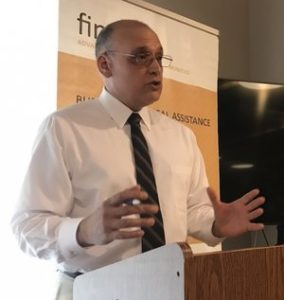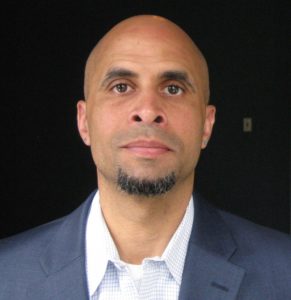Predictions for nonprofits 2021
 December 23, 2020
Category: Featured, Long, Purpose
December 23, 2020
Category: Featured, Long, Purpose
It feels like its taken a decade to get through the past 12 months. What a year. But here we are, at last, on the cusp of a new one.
We reached out to a number of nonprofit professionals and influencers, and asked them to look ahead to 2021 and tell us what they think will be:
- The sector’s greatest challenge
- The sector’s likeliest success
- The sector’s wildest dream
Here are the 30 responses we received.
Challenge: The arts and culture sector has been decimated by cancellations and lockdowns
 Faye Anderson
Faye Anderson
Director
All That Philly Jazz
The sector’s greatest challenge
Since the onset of the coronavirus pandemic, the arts and culture sector has been decimated by cancellations and lockdowns. The elimination of the Office of Arts, Culture and the Creative Economy and reduced funding for the Philadelphia Cultural Fund dealt a blow to an already reeling sector. Even with a vaccine, it likely will be 2021/2022 before the public will feel it’s safe to attend cultural events in person.
The sector’s likeliest success
Only the strong will survive. Recipients of grants from the Coronavirus Aid, Relief, and Economic Security (CARES) Act, William Penn, Andrew W. Mellon and Knight foundations, and other funding sources will emerge more or less intact. Arts organizations that stayed connected with their audiences with virtual events are better positioned to weather the pandemic.
The sector’s wildest dream
Congress passes the DAWN Act: Defend Arts Workers Now which authorizes $44 billion in federal relief funds for the arts and culture sector. Enactment of the Save Our Stages Act would help independent venues like Ardmore Music Hall, Chris’ Jazz Café, Johnny Brenda’s, SOUTH Jazz Club and World Café Live keep the lights on.
Challenge: To meet students where they are
 Beth Feldman Brandt
Beth Feldman Brandt
Executive Director
Stockton Rush Bartol Foundation
I am going to answer based on our focus on arts education rather than the whole nonprofit sector.
The sector’s greatest challenge
At the Bartol Foundation, we support arts education programs and the teaching artists who provide these experiences, including through our trauma-informed practice training. I think the greatest challenge will be to meet students where they are as they re-socialize after so much time apart, either in or out of school time.
The sector’s likeliest success
The arts are a powerful way for people to process and express all we have experienced during the past year. I think our likeliest success will be providing the outlet for people to give voice to all they have been through in 2020—their stories will be powerful.
The sector’s wildest dream
People, young and not so young, sitting in a theatre or a classroom or a dance studio or a music class. Like, together. In the same space. With snacks.
Success: The streets will continue to be the center of liberatory cultural work
 Arielle Julia Brown
Arielle Julia Brown
Founder and Director
Black Spatial Relics
The sector’s greatest challenge
The breath and life-source of the Philly arts sector is BIPOC artists who making spaces and work that intervene in systems of oppression here. We have solutions but not enough capital is coming to us directly.
The sector’s likeliest success
In 2020 the streets increasingly became the center of liberatory cultural work because of the uprisings and COVID-19. The streets will continue to be the center and we only stand to grow from that.
The sector’s wildest dream
In our wildest dreams, which are overdue not wild, the mutual aid infrastructures that have been seeded and relied on over the last year, will be nourished, sustained and resourced. This will only deepen and expand networks of support and collaboration between direct service work and freedom-centered arts work.
Success: More collaboration amongst all stakeholders
 Monique Curry-Mims
Monique Curry-Mims
Founder and Principal
Civic Capital Consulting
The sector’s greatest challenge
Understanding where our accountability lies. For nonprofits, we need to look at the work we are doing and ask if we are doing more harm than good, and who we are actually accountable to. Should it be our board and funders or those that we charged ourselves with serving. We need to listen more to their needs and problems and implement strategic and evaluative practices that work towards solving the problem and not just serving it and the community year after year. Nonprofits also need to be accountable to their employees, mental health is real. We need to listen more to our employees, what they see, and how they are feel. We can’t expect them to do the work if they are struggling themselves, mentally, physically, or morally.
The sector’s likeliest success
More collaboration amongst all stakeholders. Our sector on all fronts must come together. Nonprofits need to be less competitive and more inclusive of the voices they serve and the nonprofits that can supplement and bring value to the work they are doing. Funders need to stop sitting in collaboration and thought with other similar funders but with those that they fund and the communities that they serve. We all need to be on the same page, agreeing on priorities and best practices to move our sector forward.
The sector’s wildest dream
A community-centered sector. In 2020, we saw that our work has not been as effective as we thought. Our sector’s progress if often hindered/slowed because of our donor centered focused. What if we were held accountable to the communities we served? What if our programs, dollars, and practices were centered on uplifting our communities and solving the problems they face? What if we listened and were driven by their lived experience, and nonprofits approached their work not with solutions, but with questions? What if funders provided only general operating and trusted nonprofits to do good work, work centered around the community? What if we all cared more about the community and the problems and not the perpetuity of our individual organizations? What if it didn’t need to be wild or even a dream?
Success: Collaboration to the point of merging
 Tivoni Devor
Tivoni Devor
Director of Growth and Engagement
Urban Affairs Coalition
The sector’s greatest challenge
Competing for individual donors as more people give directly to crowdfunding sites like GoFundMe, and impact investment will attract large donors.
The sector’s likeliest success
Deep collaboration, when nonprofits focus all in on mission outcomes they will realize that collaboration to the point of merging will have better results than constantly competing for funds, staff, and other resources.
The sector’s wildest dream
A Senate that will approve a large Biden recovery stimulus plan.
Dream: Everyone should live in a place where healthy food is abundant and affordable
 Mark Edwards
Mark Edwards
President and CEO
The Food Trust
The sector’s greatest challenge
As our country begins the slow transition out of a pandemic that has driven high rates of food insecurity, poverty and mortality — revealing and deepening racial and socioeconomic health disparities in communities across the country — we are challenged to meet the needs of our most vulnerable neighbors when they are at their most vulnerable. Far too many families in Philadelphia and across the U.S. are being forced to choose between eating healthy and paying the bills, eating healthy and making rent, eating healthy and filling prescriptions, eating healthy and eating enough.
The sector’s likeliest success
If 2020 has taught us anything, it’s that we cannot do this alone. Collaboration is at the heart of our work, and it will be critical to our success in 2021: The Food Trust and other organizations like us will continue to find new and innovative ways to join forces — ways we haven’t tried before, ways that will truly meet the needs of the people we’ve dedicated our careers to serving.
The sector’s wildest dream
Everyone should live in a place where healthy food is abundant and affordable. As we turn to our partners to help us realize our mission, we can turn our collaboration into collective impact by thinking big: not just about healthy food access, but all the social determinants of health that affect our constituents’ quality of life. If we can bring grocery stores, and jobs, and housing, and health care, and investment to a single neighborhood, our impact will have positive ripple effects on that community for generations to come. It’s a big dream, but — with the right partnerships, strategy and vision — an achievable one.
Success: Organizations that deliver impact on health and wellness
The sector’s greatest challenge
The biggest challenge will be for organizations to continually pivot their indoor experiences to appeal to and engage supporters during a prolonged recovery period.
The sector’s likeliest success
Organizations that deliver impact on health and wellness. PHS is fortunate that its work is uniquely positioned to foster increasing health and well-being in the greater Philadelphia region through its year-round programs and services. Through its tree stewardship and planting, food growing and sharing, 150+ acres of public gardens, community gardening network, vacant land stabilization, and workforce development programs and, its new outdoor presentation of the Philadelphia Flower Show in 2021, PHS is on course to achieve increasing participation from many new audiences who recognize the relevance and impact of these efforts now more than ever before.
The sector’s wildest dream
That a pervasive feeling of gratitude coming out of the pandemic results in the prioritization of philanthropy as the preferred path forward in our collective recovery.
Success: Stabilizing and supporting our communities
 Dawn Frisby Byers
Dawn Frisby Byers
Senior Director of Content and Engagement
Pennsylvania Humanities Council
The sector’s greatest challenge
2020 was exhausting! We have to find new and effective ways to help our partners inspire their communities despite the anticipated challenges of rebuilding in 2021.
The sector’s likeliest success
If we can stabilize and support our communities so everyday people have breathing room, we can start the hard and important work of recovery.
The sector’s wildest dream
Not “returning to normal” but building a new future where community engagement can be reimagined and the sector’s programs, grants, and events effectively serve those that need them most.
Success: Keeping everyone accountable about diversity, equity and inclusion
 Ben Goebel
Ben Goebel
I Belong Group
The sector’s greatest challenge
Keeping everyone accountable about diversity, equity and inclusion (DEI). DEI is a lot more than adding a DEI director or writing a BLM statement and we need to keep pushing for systemic and cultural changes.
The sector’s likeliest success
I’m French so I am mostly pessimistic, but I believe that if we build on the movements that are finally being listened to, we could ensure that there is more participation from every Philadelphian in the local affairs, which will ensure more representation, which should ensure more solutions to problems facing Philadelphia.
The sector’s wildest dream
That political, civic, nonprofit and business institutions come together to solve the issues that are most pressing, and make money available to fund important and necessary programs to uplift the ones who need it the most.
Challenge: Ensuring immigrants are included in the economic recovery efforts
 Peter Gonzales
Peter Gonzales
President and CEO
Welcoming Center for New Pennsylvanians
The sector’s greatest challenge
Our sector’s greatest challenge will be ensuring immigrants are included in the economic recovery efforts, not just as frontline and essential workers, but as thought leaders and strategic decision-makers.
The sector’s likeliest success
Our sector’s likeliest success will be that the courage, drive and entrepreneurial spirit of immigrants will continue to spread across the region. Immigrants will be recognized not only for the critical role they have been playing in protecting the public’s health during the pandemic, but as drivers of innovation and growth for companies and communities across the region.
The sector’s wildest dream
My wildest dream for our sector is for philanthropic, civic and business leaders to join The Welcoming Center‘s commitment to investing in immigrant inclusion because they understand that everyone benefits, now and future generations.
Dream: Immigration reform. It is the economic engine that will restart our nation’s economy
 Will Gonzalez
Will Gonzalez
Executive Director
Ceiba
The sector’s greatest challenge
The sector’s greatest challenge is addressing deep poverty in Philadelphia. COVID-19 made it deeper especially in the Latino community; Hispanics are the poorest ethnic group in the city and the folks most affected by the pandemic.
The sector’s likeliest success
The sector’s likeliest success will be keeping most of the nonprofits in the region alive and working, with more equity, post the pandemic.
The sector’s wildest dream
Immigration reform. It is the economic engine that will restart our nation’s economy. Imagine when we fully integrate millions of unauthorized immigrants into our society by granting them work authorization. It gives this group of hard working people the ability to secure better jobs, and easily access mortgages, car loans, etc.
Dream: Selflessness and commitment to supporting missions
 Brian Gralnick
Brian Gralnick
Director, Social Responsibility
Jewish Federation of Greater Philadelphia
The sector’s greatest challenge
The greatest challenge we face is of course the unprecedented COVID-19 pandemic. Combined with a sharp rise of economic hardship and social distancing measures, its’ harder than ever to save lives and keep families afloat.
The sector’s likeliest success
The success we are already seeing is the adaption to using technology for our services. Continuing the use of this tech for services, programs and connections will further efficiencies and expand access to otherwise unreachable communities.
The sector’s wildest dream
Our wildest dream is that, even when the COVID era passes, the selflessness and commitment to supporting missions like ours will continue.
Dream: Create powerful coalitions of innovative nonprofits
 Sharon Kelly Hake
Sharon Kelly Hake
CEO and President
Great Dames, Inc.
The sector’s greatest challenge
To ensure that our work is focused on solving the most important social, political, cultural, and environmental challenges facing us in the next decade — with passion, commitment and urgency.
The sector’s likeliest success
To reimagine our work in ways that help us discover new opportunities to embrace more people, and increase access and impact.
The sector’s wildest dream
To create powerful coalitions of innovative nonprofits to address intersecting needs of people and communities in ways that dramatically increase our impact.
Challenge: Decolonizing our identities, imaginations, institutions and practices
 Eric Hartman
Eric Hartman
Executive Director
Center for Peace and Global Citizenship
The greatest challenge before us is decolonizing our identities, imaginations, institutions and practices —toward more just, sustainable, inclusive and liberatory futures. I’m encouraged by the many activist, publicly-engaged scholars who are applying analysis to not only naming but also doing — decolonizing philanthropy and nonprofit (including university) practices. I think of Megan Ming Francis‘ work across the country with Philanthropy and Social Movements and, closer to home, Penn GSE Assistant Professor Krystal Strong‘s Activism beyond the Classroom course. Each of the links there show how classroom spaces themselves can become porous, inclusive centers of critical reimagination of public structures and processes, and each of the scholars I mention advance applied scholarship that influences other organizers and institutions toward better, decolonizing actions.
Challenge: Lack of political will, motivation and courage
 Michael Hinson
Michael Hinson
President and Chief Operating Officer
SELF, Inc.
The sector’s greatest challenge
I believe the public service sector’s greatest challenge is the lack of political will, motivation and courage desperately needed from elected, appointed and anointed leaders to transform the ill effects of poverty that show up as roadblocks to successful, safe and healthy living i.e. gun violence, poor educational outcomes, HIV/AIDS, homelessness, joblessness, etc. These roadblocks severely impact the life outcomes of Philadelphia majority populations — Black, brown and poor communities.
The sector’s likeliest success
I believe the public service sector’s likeliest success will be the dismantling of public and private practices and systems informed and formed by years of racism, bias, discrimination and oppression that have birthed a circular wheel of poverty, self-hate and dependency. These transformational efforts are currently being led by authentic and organic community members, workers, and thought leaders i.e. Black Lives Matter, Me Too Movement, Trans Lives Matter, Latinx Racial Justice Movement, etc.
The sector’s wildest dream
I believe the public service sector’s wildest dream is to light up Philadelphia with the smiles of opportunity and success shown on the faces and the walk of the courageous, resilient, innovative, smart, and caring folks that have been left on the margins too often, but because we listened they no longer need to be resilient — they will thrive and contribute to the transformation of communities block by block, neighborhood by neighborhood living into their best lives for all of Philadelphia to celebrate leaving no one behind!
Dream: A movement that goes beyond donating to initiatives to invest in nonprofits delivering solutions
 Farah Jimenez
Farah Jimenez
President and CEO
Philadelphia Education Fund
The sector’s greatest challenge
Our clients not only need us more than ever, they also need us to show up differently given COVID and the economic downturn. However, given how nonprofits are funded, we operate on such thin margins leaving little in the way of resources to fund innovation and experimentation. Of course, nonprofits are resilient and committed, so we will try not to let this reality get in the way of our getting creative when it comes to serving those who need us.
The sector’s wildest dream
Nonprofits are first responders for those challenges that ail our community. This was never more clear than during the pandemic, when government and the private sector turned to nonprofit partners to help mobilize responses to emerging and growing food, housing, and educational disparities. It would be my hope that this enhanced awareness of the vital role played by nonprofits, would inspire a movement that goes beyond “donating” to an initiative and moves toward “investing” or “underwriting” the nonprofit’s full cost of delivering the community solution. Let’s take some of the risk off the nonprofit sector.
Success: The impact of the shift to automate operations and service delivery methods
 Jeannine L. Lisitski
Jeannine L. Lisitski
Executive director and president
Women Against Abuse, Inc.
The sector’s greatest challenge
We believe the nonprofit sector’s greatest challenge will be to secure sustainable funding, particularly as our world continues to experience the repercussions of the economic fallout caused by COVID-19.
The sector’s likeliest success
One success will be the long-term impact of the sector’s shift to automate operations and service delivery methods in response to the pandemic and need for remote operations. We believe that this will have a profound impact on the sectors’ productivity and free up human resources to focus on innovation and impact.
The sector’s wildest dream
Our dream for the nonprofit sector is that funders would be responsive to community need and empower service providers to allocate funds in the most strategic way possible to achieve the greatest impact, rather than imposing an overabundance of restrictions or prescribing deliverables that are out of touch with the true needs of the people we serve.
Success: Likely the biggest investment we’ve seen in community development in decades
 Beth McConnell
Beth McConnell
Policy Director
Philadelphia Association of Community Development Corporations
The sector’s greatest challenge
Realizing meaningful downward movement in poverty in Philadelphia, especially in our neighborhoods where the poverty rate is 50% or higher.
The sector’s likeliest success
Thanks to the passage of the Development Impact Tax by City Council on December 10 and a likely $400M bond as a result, the biggest investment we’ve seen in community development in decades that will create and preserve more affordable homes, and help small businesses on our neighborhood corridors re-open, re-cover and begin thriving again.
The sector’s wildest dream
A complete overhaul of the way Washington funds affordable homes in ways that are faster, more efficient, prioritize the lowest income residents, and leave no one behind.
Challenge: We are in the midst of housing crisis that isn’t going away anytime soon
 Dr. Bill McKinney
Dr. Bill McKinney
Executive Director
New Kensington Community Development Corporation
The sector’s greatest challenge
Poverty. We are in the midst of housing crisis that isn’t going away anytime soon. Before the current crisis we already had an inequitable housing system based on racism and generational poverty and then, through lack of leadership and lack of attention and funding, the suffering has only increased.
The sector’s likeliest success
We will continue to serve those in greatest need despite the incredible obstacles that are constantly placed in our way. We will continue to expand collaborations among partners committed to shared core values which will lead to greater impact in our communities.
The sector’s wildest dream
The wildest dream is that root causes of the problems we are addressing are recognized, and that efforts to address not just the symptoms but the causes of problems are properly supported. The recognition that — by centering communities, residents and organizations that deal with the whole person, whole family and whole community and all of the factors that they face — we will have greater success. A dream of centering organizations that have prioritized a comprehensive approach while also addressing racial equity and trauma, and a dream that resources do not continue to flow in directions that have been unsuccessful in the past.
Challenge: Having to reimagine and reinvent approaches to programs, engagement, fundraising
Paula Marincola
Executive Director
The Pew Center for Arts & Heritage
The sector’s greatest challenge
The greatest challenge will clearly be the continuing effort to recover from the effects of the pandemic, which has kept arts organizations closed to the public for the majority of this year. Across the cultural sector, organizations are having to reimagine and reinvent their approaches to programs, audience engagement, facilities usage, and fundraising — a huge lift during a tremendously difficult time.
The sector’s likeliest success
Cultural institutions and artists have already shown incredible perseverance and resilience in the face of enormous uncertainty, and that is its own success. But the sector can continue to find the creative opportunities within the moment’s many challenges by focusing on the value of their core missions and increasing their commitment and relevance to those they hope to reach and serve, especially with respect to BIPOC artists and audiences. What can follow then is a re-energized, deepened relationship expressed through programs — virtual or in-person — that reflect the vital experiences and stories of those diverse communities.
The sector’s wildest dream
This isn’t a wild dream, but it is an important one: that the arts embody their highest values by playing a transformative role in the ongoing creation of a truly just and equitable society.
Dream: Working ourselves out of our jobs
 Caitlin O’Brien
Caitlin O’Brien
Director of Learning & Community Impact
Thomas Scattergood Behavioral Health Foundation
The sector’s greatest challenge
Resources — and not because they don’t exist, but because they aren’t distributed equitably or justly. We’ll need a significant cultural shift to ensure that resources are directed toward collective good.
The sector’s likeliest success
Building healthy, authentic, and productive collaboration. The challenges we face require an all-hands-on-deck approach. I think we’ll see deeper and more meaningful partnerships among funders, organizations, government, and communities that will result in greater outcomes for everyone.
The sector’s wildest dream
Working ourselves out of our jobs.
Success: We realize that DEI and partnership isn’t a nicety but a necessity
 Sulaiman Rahman
Sulaiman Rahman
President and CEO
DiverseForce
The sector’s greatest challenge
I believe we are on the verge of a recession that will cause the sector to tighten through mergers, acquisitions, and closures.
The sector’s likeliest success
We will realize that diversity, equity, inclusion, and partnership is not a nicety in the social impact sector, but a necessity.
The sector’s wildest dream
Although we’ll have to trim, it will be the pruning necessary to catapult the impact of the sector by 100x over the next 10 years!
Challenge: Getting out of the bunker mentality and thinking big
 Dan Rhoton
Dan Rhoton
Executive Director
Hopeworks
The sector’s greatest challenge
The sector’s biggest challenge will be getting out of the bunker mentality and thinking big and working hard to make big changes that are long overdue. The pandemic didn’t create new problems, but really showcased just how inequitable and broken our systems are, and how ineffective the nonprofit sector has been in addressing those problems and systems for the last decade, even when things were “going well” economically. The nonprofit sector, instead of jumping to the forefront and being a leading force for change during this time — arguably their job — in some places hunkered down and moved to a scarcity/crisis mindset. Although there are some notable exceptions, almost a year into the pandemic, there are still nonprofits that are waiting until things get better to help the community rather than stepping in, seeing the opportunity for transformative change, and getting to work. The money is there, and the need is certainly there. The nonprofit sector needs to step up and do its job.
The sector’s likeliest success
Nonprofits with the ability to quickly pivot, innovate and build strong operations and program staff really stepped up and delivered for their communities in really impactful ways during the pandemic, showing the whole region just what the sector can do. Hopefully, this “weaning” in which high performing organizations became clearly differentiated from low performing organizations will help set a new bar for expectations about what the sector can, and should, be doing as far as structural change.
The sector’s wildest dream
For too long, the nonprofit sector has subsisted on crumbs and on the idea that they are a band-aid for the massive racial and structural inequities. Ironically, the lack of imagination in the sector has not only not helped, but, in some cases, helped perpetuate these racial and structural inequalities by propping up bad systems and actors. The pandemic laid bare just how broken our systems are, something that was not news to many people in our impacted communities but was somehow surprising to policymakers and leaders. At Hopeworks, we are dreaming that this experience will move more organizations out of the “band-aid” business and into the equity business.
Dream: BIPOC-led organizations, mutual aid collectives and youth having a seat at board room tables
 Fran Rodriguez
Fran Rodriguez
Senior Program Officer
Lancaster County Community Foundation
The sector’s greatest challenge
Amplifying the voices of community members — folks who’ve experienced, witnessed and understand what works.
The sector’s likeliest success
The pandemic forced us to reimagine time, space, relationship-building and holding conversations. 2021 will be the year of heightened creativity.
The sector’s wildest dream
An emergence of philanthropic opportunities for people and organizations with no strings attached. Communities with BIPOC-led organizations, mutual aid collectives and youth having a seat at board room tables.
Success: A ‘new normal’ of collaboration, trust, and generosity
 Katherina Rosqueta
Katherina Rosqueta
Founding Executive Director
Center for High Impact Philanthropy
The sector’s greatest challenge
How to use its limited resources to close the disparities in educational, economic, and health outcomes that grew even wider due to the COVID-19 pandemic. For example, McKinsey estimates that distance learning will exacerbate existing academic gaps for low-income, Black, and Hispanic/Latinx students by 15% to 20%. People of color (POC), and Black Americans in particular, are hospitalized and dying at roughly 3x the rate of White Americans. These disparities reflect a tragic loss of human potential and threaten communities everywhere.
The sector’s likeliest success
A ‘new normal’ of collaboration, trust, and generosity. Responding quickly to a crisis at the scale of COVID-19 required a remarkable level of collaboration and trust, among funders and between funders and grantees. That was evident in the work behind the COVID-19 Response Dashboard that tracked the grantmaking of 13 regional funds, all created in just two weeks. Those funds made $40,133,289 of grant awards just in the initial response phase from March 18 to June 29, 2020, and many continue to work together to address the ongoing need.
The sector’s wildest dream
That the commitment to addressing inequity — particularly racial inequity — and the collaboration and trust reflected in our best COVID-19 response efforts continues long after the pandemic ends. Because if it does, we will have used this crisis to truly build back better.
Challenge: Facing the ways that our work perpetuates inequalities
Daniella Scruggs
Development Director
HIAS Pennsylvania
The sector’s greatest challenge
With the soul-searching that the death of George Floyd has invoked in us all, the biggest challenge in the non-profit/philanthropy sector is facing the ways that our work perpetuates inequalities. From the fundamental power dynamic between funders and organizations, to the band aid approach to solving systemic problems, the biggest challenge is to move beyond the status quo to real change.
The sector’s likeliest success
Over the past year, we’ve seen corporations, the city, and nonprofits come together around basic needs, from food to computers. I think that we will continue in this direction, coming together to solve immediate needs.
The sector’s wildest dream
I think the wildest dream is fundamentally changing the way we operate, where funders invest in organizations long term without complicated grant requires that take time and effort away from those in need. Where we invest in real policy change rather than band-aid solutions. Where we focus on the needs of the community, not the wants of the donors. In short, many of the goals of Community Centric Fundraising.
Success: Organizations collaborating and partnering at new levels
 Rev. Michelle Simmons
Rev. Michelle Simmons
Founder and CEO
Why Not Prosper, Inc.
The sector’s greatest challenge
The sector’s greatest challenge will be nonprofits being able to dispel systemic racism on all levels as it relates to our population, including racism within our clients and racism that affects our funding and opportunities.
The sector’s likeliest success
The sector’s most likely success is going to be organizations collaborating and partnering at new levels, breaking the silo mentality.
The sector’s wildest dream
The sector’s wildest dream is that small grassroots organizations receive funding from large white organizations without having to jump through big hoops.
Success: The ability for communities to mobilize in response to the issues affecting them
 Kristal Sotomayor
Kristal Sotomayor
Programming Director of Philadelphia Latino Film Festival
Co-founder/Journalist of ¡Presente! Media
Director/Producer of Expanding Sanctuary
The sector’s greatest challenge
I think the greatest challenge to the arts nonprofit sector is the fact that audiences may still not be able to engage in-person at theaters, museums, venues, etc. The fact that those spaces are closed will make it difficult for artists and the nonprofit sector to sustain itself. These spaces also provide a refuge for creativity and collaboration. When these spaces are unable to operate, how can virtual spaces sustain those work practices?
In 2021, I think being able to earn a living doing virtual programming will be vital. I don’t think virtual art platforms and exhibitions will end even if there is a vaccine for the coronavirus. Also, how do we engage funders to continue to support art that does not have an in-person component? Perhaps after the vaccination process, artists will want to continue online programming. How can we guarantee support for the arts both online and in-person?
The sector’s likeliest success
The ability to do virtual programming in such a quick turn-around time has been a huge success. At the Philadelphia Latino Film Festival, we were able to quickly put together our virtual programming in June. At the time, we were the first local film festival to run a completely virtual online program during the pandemic. The lesson learned from that experience is that our reach can only grow when we invest in online programming. Our friends at the Philadelphia Asian American Film Festival were able to do a whole 11-day program online! We truly commend all of our colleagues that were able to pull off incredible art in a virtual space such as SIFTMedia 215, Scribe Video Center, BlackStar, PhillyCAM, and more!
Also, the ability for communities to mobilize in response to the issues affecting them has been inspiring! The amount of mutual aid groups, emergency funding, and collectives organizing to improve the community is incredible.
The sector’s wildest dream
For me, my wildest dream would be for funders to invest in general operating support to allow artists and nonprofits to determine what work to do given their own vision. The model of project-based funding makes it difficult for organizations to express their creativity or even engage the community in the best way because of the funding’s limitations and requirements.
Also, the granting landscape in Philadelphia needs larger grants that fund artists directly. The Independence Public Media Foundation, particularly Nuala and Molly, are spearheading this initiative. IPMF’s latest grant has reinvigorated the Philadelphia independent filmmaking community in an unprecedented way. I hope other foundations follow their example!
Success: More individuals and institutions will donate their time and resources to those most marginalized
 Salima Suswell
Salima Suswell
Founder and Executive Director
Philadelphia Ramadan and Eid Fund
The sector’s greatest challenge
I believe the sector’s greatest challenge will be rebuilding from the challenges placed upon us due to the COVID-19 pandemic. I also see the opportunity the pandemic has provided us all, as we reflect upon the importance of philanthropy and aiding those in need.
The sector’s likeliest success
The sector’s likeliest success is that based upon the unique challenges faced by already disadvantaged populations across the country, many more individuals and institutions will donate their time and resources to those most marginalized.
The sector’s wildest dream
The sector’s wildest dream is that the coming presidential administration will lead this nation with the compassion and integrity promised during the election, and that the American people will remain engaged, holding all of our elected leaders accountable to establish the change necessary for our communities to advance forward.
Dream: The end of racism in America
 D.J. Thornton
D.J. Thornton
Vice President, Development & Strategic Partnerships
Urban Affairs Coalition
The sector’s greatest challenge
The greatest challenge in the sector will be to maintain the momentum of social and economic change we have discovered through 2020. The pandemic and the renewed fight for social justice has disrupted the sector and created opportunities to reimagine the sector.
The sector’s likeliest success
The sector’s likeliest success will be the continued focus and priority of the corporate sector. As organizations continue to evolve their understanding of social and community issues, so too (hopefully) will their engagement and commitment.
The sector’s wildest dream
The end of racism in America.
Get stories like this daily in your inbox
Trending News














